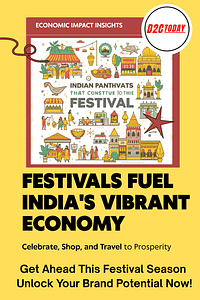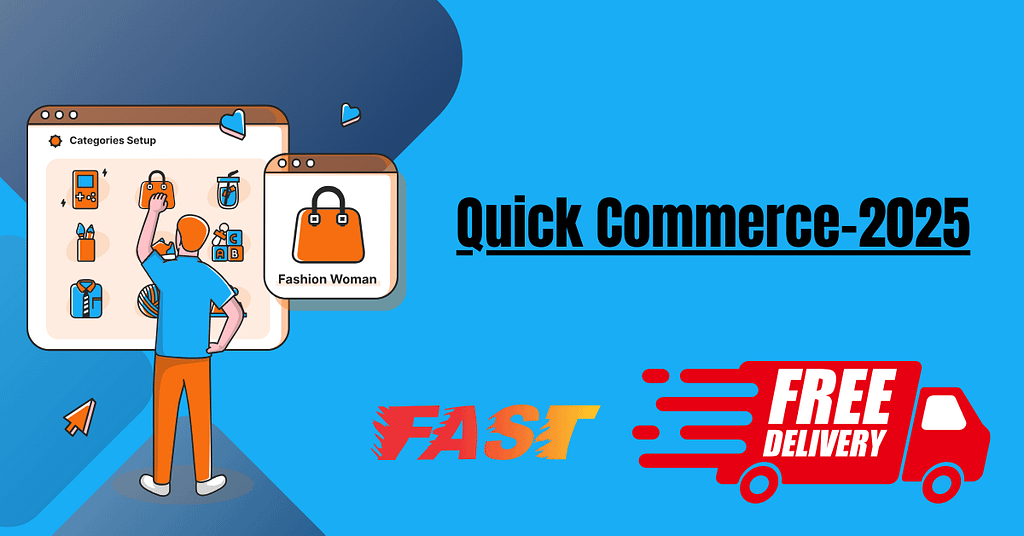The rapid evolution of quick commerce, or q-commerce, in India has transformed consumer expectations, particularly with the advent of 15-minute delivery services. This series of newsletter delves into the current landscape of quick commerce in India, examines the trends in 15-minute grocery deliveries, analyses Amazon India’s strategic entry into this sector, explores the future trajectory of Indian e-commerce by 2025, and discusses the logistical challenges inherent in quick commerce.
The Rise of Quick Commerce in India
Quick commerce refers to the ultra-fast delivery of goods, typically within 10 to 30 minutes, focusing on daily essentials like groceries, medicines, and household items. This model has gained significant traction in India, driven by urban consumers’ increasing demand for convenience and speed.
In 2020, India’s quick commerce market was valued at approximately $100 million. By 2024, it had surged to an estimated $6 billion, reflecting a compound annual growth rate (CAGR) of over 100% .This exponential growth is attributed to factors such as increased internet penetration, a growing urban population, and changing consumer lifestyles favouring convenience.
Several key players have emerged in India’s quick commerce landscape:
- Blinkit (formerly Grofers): Pioneered 10-minute grocery deliveries, setting a new industry standard.
- Swiggy Instamart: Leveraged its existing food delivery infrastructure to offer rapid grocery deliveries.
- Zepto: A startup that gained significant market share by focusing exclusively on quick commerce, raising $665 million in funding in 2024, increasing its valuation to $3.6 billion .
- Amazon India: Entered the quick commerce market with trials for 15-minute grocery deliveries, intensifying competition.
15-Minute Grocery Delivery Trends
The promise of 15-minute grocery deliveries has reshaped consumer expectations, making rapid fulfilment a standard rather than a luxury. Companies achieve these swift deliveries through strategically located dark stores—small warehouses situated in densely populated urban areas.
In 2024, Zepto announced plans to double its dark stores to over 700 by March 2025, aiming to enhance its delivery capabilities ,Similarly, Blinkit and Swiggy Instamart have expanded their networks to meet the growing demand for rapid deliveries.
Consumer adoption of quick commerce has been robust. A report by Bain & Company indicated that quick commerce orders accounted for about 40% to 50% of India’s e-grocery expenditures in 2024. Additionally, approximately 55% of festive orders placed in India in 2024 were by first-time customers on quick commerce platforms, highlighting the sector’s expanding reach .
Amazon India’s Quick Commerce Strategy
Amazon India’s entry into the quick commerce market marks a strategic expansion of its services. In December 2024, Amazon began piloting 15-minute grocery deliveries in select cities, aiming to leverage its extensive logistics network and vast seller ecosystem.
Amazon’s approach focuses on:
- Selection: Offering a wide range of products beyond groceries, including daily essentials and household items.
- Speed: Utilizing its existing infrastructure to ensure rapid deliveries, competing directly with established players like Blinkit and Swiggy Instamart.
- Convenience: Integrating quick commerce services into its existing platform, providing a seamless experience for customers.
This move positions Amazon to capture a significant share of the burgeoning quick commerce market, challenging both local startups and global competitors.
Future of Indian E-Commerce by 2025
The Indian e-commerce sector is poised for substantial growth, with projections indicating a market size of $120 billion by 2025.Quick commerce is expected to play a pivotal role in this expansion, particularly in tier-2 and tier-3 cities .
Key trends shaping the future include:
- Category Expansion: Quick commerce is anticipated to extend beyond groceries into categories like electronics, fashion, and pharmaceuticals, offering consumers a broader range of products with rapid delivery times.
- Technological Integration: Advancements in artificial intelligence and machine learning will enhance inventory management and demand forecasting, improving efficiency and customer satisfaction.
- Sustainability Initiatives: Companies are likely to adopt eco-friendly delivery practices, such as electric vehicles and sustainable packaging, to address environmental concerns.
- Regulatory Developments: Government policies and regulations will play a crucial role in shaping the operational frameworks and competitive dynamics of the e-commerce sector.
Challenges in Quick Commerce Logistics
Despite its rapid growth, quick commerce faces several logistical challenges:
- Infrastructure Limitations: Ensuring rapid deliveries requires a dense network of dark stores and efficient last-mile delivery systems, which can be capital-intensive.
- Operational Costs: Maintaining ultra-fast delivery times often involves higher operational expenses, impacting profitability.
- Workforce Management: Recruiting and retaining delivery personnel, while ensuring fair labour practices, remains a significant challenge.
- Supply Chain Complexity: Coordinating with multiple suppliers to maintain real-time inventory levels demands sophisticated supply chain management systems.
- Regulatory Compliance: Navigating the regulatory landscape, including labour laws and zoning regulations for dark stores, adds to the complexity of operations.
Addressing these challenges is essential for the sustainable growth of quick commerce in India.
In Summary
The rapid evolution of quick commerce in India, driven by 15-minute delivery services, is not just a reflection of technological advancements but a profound shift in consumer behavior and business models. As this trend reshapes retail, it is important to explore its long-term implications on industries, infrastructure, and society.
Quick commerce has redefined convenience, catering to the growing demand for instant gratification in urban India. For businesses, it offers an opportunity to capture a larger market share and build deeper connections with consumers by delivering value at unprecedented speed. However, the sustainability of this model requires strategic planning. Companies must optimize logistics, manage high operating costs, and maintain profitability while balancing environmental impact.
Looking ahead, the future of quick commerce will likely be shaped by several factors. Advancements in AI and predictive analytics will streamline supply chains, ensuring faster and more accurate deliveries. Autonomous vehicles and drones could revolutionize last-mile delivery, reducing human dependency and operational inefficiencies. Moreover, hyper-localized inventory hubs will play a crucial role in maintaining the speed and efficiency of services.
On the flip side, challenges persist. The environmental toll of quick commerce, including packaging waste and carbon emissions, demands innovative solutions. Companies must adopt greener practices, such as reusable packaging and electric delivery fleets, to align with global sustainability goals. Furthermore, the well-being of gig workers powering this ecosystem must be prioritized to create an equitable business model.
In the coming years, quick commerce could evolve beyond groceries and essentials, influencing sectors like healthcare, fashion, and lifestyle products. The integration of technology and consumer-centric strategies will determine its success. Ultimately, the quick commerce revolution signifies a future where speed, convenience, and sustainability converge, transforming the way India shops and lives.
FAQs
1. What is quick commerce, and how does it work in India?
Quick commerce refers to ultra-fast delivery services, often within 10-15 minutes, for groceries, essentials, and daily-use items. In India, quick commerce relies on a network of hyper-local warehouses, advanced logistics, and real-time inventory management to fulfill consumer orders swiftly.
2. Why is 15-minute delivery gaining popularity in India?
The rise of 15-minute delivery in India is driven by urban consumers’ demand for convenience and instant gratification. With busy lifestyles and smaller household storage capacities, quick commerce offers a solution by ensuring fast access to daily essentials without planning ahead.
3. Which industries are benefiting the most from quick commerce in India?
The grocery, food, and pharmaceutical sectors are among the biggest beneficiaries of quick commerce in India. However, categories like personal care, home essentials, and even pet supplies are also seeing rapid growth through instant delivery services.
4. What are the challenges faced by quick commerce in India?
Quick commerce in India faces challenges like high operational costs, environmental sustainability concerns, and pressure on gig workers. Ensuring profitability while managing carbon emissions, traffic congestion, and worker welfare are critical hurdles for this emerging industry.
5. What does the future of quick commerce look like in India?
The future of quick commerce in India includes advancements like drone-based deliveries, AI-driven supply chains, and eco-friendly packaging solutions. As consumer demand grows, quick commerce is expected to expand beyond essentials to include lifestyle products, creating a more versatile and sustainable ecosystem.








3 thoughts on “The Rise of Quick commerce: 15 – Minutes deliveries reshaping e-commerce in India”
After all, what a great site and informative posts, I will upload inbound link – bookmark this web site? Regards, Reader.
Its good as your other articles : D, regards for posting.
What i do not realize is in truth how you’re now not really much more neatly-appreciated than you may be now. You are so intelligent. You already know thus considerably when it comes to this subject, produced me personally believe it from numerous various angles. Its like men and women aren’t interested except it is one thing to accomplish with Girl gaga! Your own stuffs excellent. At all times maintain it up!